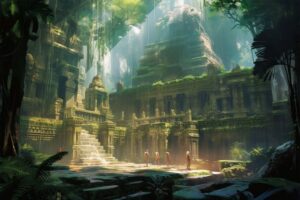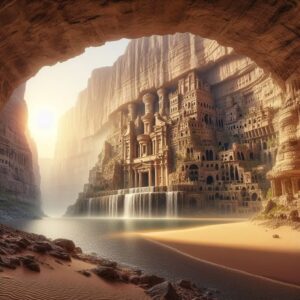
Kavindya Senevirathna
Human history is an eternal journey of goo although our modern society is built on agriculture, city-building, and scientific knowledge, some of the great civilizations of the past centuries still remain among the darkest mysteries to us today. While some cities have been identified by archaeologists through extensive exploration, there are many more lost cities that still lie dormant without complete answers. They open new doors to human perception and thought and raise questions about our origins.
Among these lost cities, three that have been widely discussed around the world are Atlantis, Petra, and Machu Picchu. Atlantis is a legendary city that first appeared in the writings of the great Greek philosopher Plato. It is a mystery that blurs the line between fact and fiction because it has yet to be found.
Similarly, the city of Petra, hidden among the Rocky Mountains of Jordan, became popular as the “City of Red Rock” due to its magnificent rock-cut architecture and epic beauty. Rediscovered by European explorers, this city is still an essential center for exploring the artistic and cultural resources of the past.
Then, Machu Picchu, located high in the mountains of Peru, was recognized by the world as an example of the urban and religious genius of the Inca Empire. This city had long disappeared and was only rediscovered in the 20th century.
Although these three cities were established in completely different cultural settings, what connects them is the mystery of the past. Therefore, when we explore Atlantis, Petra, and Machu Picchu, we can see in a new light not only our past but also the hypotheses, beliefs, and abilities to build visions of the future in the human mind.
Atlantis
Atlantis is a city that has long been considered a mysterious metropolis in human history. The first mention of the city was made by the famous Greek philosopher Plato during the time of Socrates. According to his works Timaeus and Critias, Atlantis was a highly lawful and strong civilization, but it was eventually destroyed after the excessive arrogance and lust for power of man.

According to Plato’s description, Atlantis was a large island “beyond the dawn.” It was described as a civilization that excelled in beauty, commercial development, and scientific knowledge. The city consisted of a central circle surrounded by rings and was considered to have a high level of mechanization and urban planning.
However, this city has been the subject of much controversy among later explorers. Some believe that Atlantis was not a real city but a philosophical concept of Plato. Others believe that it was not a fictional city but a cultural admonition, a teaching on human life and the use of power.
Some researchers also suggest that it could have been a city in the deep waters of the Caribbean, Greece, or the Mediterranean. In particular, there is a group of scholars who have said that an old volcano on the island of Santorini may have caused the destruction of Atlantis.
Although there is no real evidence for Atlantis, it has had a great poetic impact on the human psyche. Even today, Atlantis is constantly discussed in films, stories, scientific research, and popular imagination as a mystery about a lost civilization.
Petra
Petra is one of the world’s most famous “lost cities,” located in Jordan. Known as the “city carved out of red rock,” it is also considered one of the world’s most amazing places for rock art.

Petra was built by an ancient people called the Nabataeans. They were primarily involved in trade routes, and their large stone-carved houses, temples, and aqueducts showed their high level of craftsmanship. The most famous building here is Al-Khazneh, also known as the “Treasury.”
The city’s location made it a hub connecting Asia, Africa, and Europe, thanks to its strategic position on military routes, trade routes, and access to water resources. However, as the Roman Empire rose to power, Petra was slowly destroyed by floods and earthquakes. As the roads changed, it became a lost city.
Rediscovered by European explorers in the early 19th century, Petra is now a UNESCO World Heritage Site. What makes it so fascinating are the large buildings carved into the rock and the dark passageways that lead to them.
Even today, scholars who explore Petra believe that it was a cultural museum of the Nabataeans. It is a magnificent example of the relationship that humanity built with stone.
Located in the Andes Mountains of Peru, Machu Picchu is one of the most amazing ancient cities in the world. It is believed to have been built by the Inca Empire in the 15th century. Machu Picchu is located entirely on a mountain peak. When seen through the mists of the mountains, it seems to be quietly guarding the city.

The Incas created stone buildings with great engineering skills. The houses, temples, and agricultural structures, built from the rocks of the city, showed their great architectural ability. In particular, the Intihuatana Stone, which was created to worship the sun god, is a sign of their religious spirit.
But there is a great mystery about Machu Picchu. What exactly the Incas used it for is still a matter of debate among scholars. Some believe it was a royal residence. Other scholars say it was an Incan religious center, and still others claim it was a center of resistance during war.
When the Spanish conquered the Inca Empire in the 16th century, Machu Picchu became a lost city. It was rediscovered in 1911 by explorer Hiram Bingham and is now considered one of the world’s new wonders.
Scholars exploring Machu Picchu today believe that it represents the highest level of urban ingenuity, artistic talent, and religious fervor of the Inca people.
Atlantis, Petra, and Machu Picchu are lost cities that have been quietly rediscovered or are yet to be found. All three cities represent the great urban ingenuity, religious beliefs, and artistic talent that have been built throughout human history. But they also remind us that human power, pride, and the misuse of resources can sometimes lead to destruction. Although the mysteries of these cities have not been fully solved today, it is our responsibility to preserve them as world treasures. Ultimately, the stories of lost cities teach us the need to preserve the past while building the future.